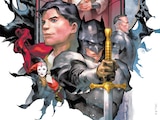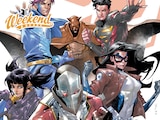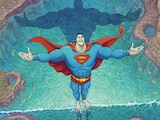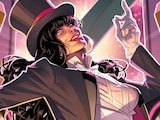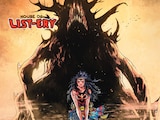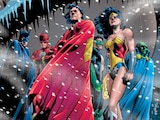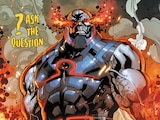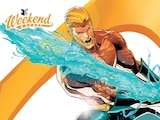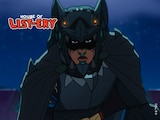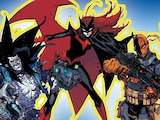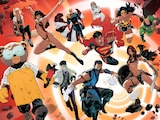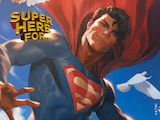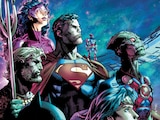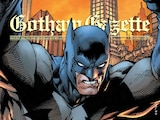It's always a good time to read comics by the brilliant Black creators who have shaped some of our favorite characters. Here at DC.com, it's a pleasure to highlight heroes like Nubia, Cyborg and Vixen, and this Black History Month, we're digging into the back issue bins in order to recommend some classic DC comic arcs from Black creators. Making good use of heroes as eclectic as Plastic Man, the Question, Batgirl and the Justice League, these are must read stories by some of the most influential creators in DC’s history.

 Plastic Man
Plastic Man
Kyle Baker is the one of the greatest cartoonists of his generation and he showcased his ingenuity, style and humor in this one-of-a-kind take on DC's Plastic Man. Playing with our expectations of superhero comics, Baker brings the genre to life, leaning into the history of animation for inspiration as he expands the horizons of the reader and the literal parameters of what Plastic Man can do. The story begins as Plastic Man attempts to help solve a murder with the assistance of his good friend Woozy Winks. Soon, though, the pair find themselves in trouble after the FBI fingers none other than Eel O'Brian, Plastic Man's alter ego, as the primary suspect.
Plastic Man's powers lend themselves to the strange and comedic, but here Baker presents a Looney Tunes-level reconsideration of the hero with cartooning and comedy to match. This is a truly dynamic work that is unlike any other superhero comic. It's collected in hardcover and can be read on DC UNIVERSE INFINITE, now making the whole series available for the first time in almost twenty years!

 The Question
The Question
In 1986, two of comics most powerful creators—who also just happened to share a name—came together to work on Steve Ditko's iconic creation, the Question. Writer Dennis O'Neil crafted a dark noir tale about the faceless detective investigating the corrupt, and penciller Denys Cowen brought it all to life in stark and immediately recognizable fashion. If you're a fan of 1986's other game-changingly gritty smash hits, Watchmen and The Dark Knight Returns, then The Question is a must read. Often feeling more like a classic pulp story than a superhero one, this is two creators at the top of their game crafting a new status quo for the Ditko character.
In this iteration, Vic Sage A.K.A. the Question is a TV journalist by day and faceless crimefighter by night. Cowen's striking and detailed art brought Sage to life in a far more human way than Ditko had chosen too. This was a real man, just trying to make his city safer while struggling with the realities of being a vigilante and the darkness that brings out in him.

 Justice League of America
Justice League of America
In 1983, penciller Chuck Patton joined Justice League of America becoming the first Black artist to draw the JLA. From issue #217, he brought his dynamic style to DC's flagship team during a time of great upheaval for the characters. This awesome run alongside writers like Paul Kupperberg, Roy Thomas, Kurt Busiek and Gerry Conway saw the famed team reimagine their roster, with Patton just as talented at drawing key Leaguers like Batman, Superman and Green Lantern as he was designing and introducing new characters like Vibe, Gypsy and Paragon.
If you're a fan of the fantastical Silver Age of DC, Patton's early work on JLA leans into that with wild villains, monsters and cosmic adventures. Later, the artist would play a part in bringing a new roster of heroes to the team when the Justice League of America relocated to Detroit. While controversial at the time, that era set a new precedent for inclusive superhero teams, something that is still inspiring creators and publishers to this day.

 Kyle Rayner Green Lantern
Kyle Rayner Green Lantern
One of the most notorious and influential Green Lantern runs of all time. Volume 3 of the series introduced a new hero taking on the mantle, a young comic book artist named Kyle Rayner. Co-created by Ron Marz and Darryl Banks, the hero began his journey in Green Lantern #48, with Banks drawing many of his appearances from Green Lantern #50until #140. A more ground-level version of the hero, Banks brought Rayner to life in gorgeous fashion and bombastic action with iconic character design and energy that pulses from the page.
The run is also notable for inspiring the term "Women in Refrigerators" after Rayner's girlfriend, Alexandra DeWitt, was murdered in grisly fashion mere issues after making her debut. That was far from its only legacy, though, as Kyle Rayner became a stalwart member of the Lantern Corps and a perennial favorite for DC cosmic readers around the world.

 Justice League of America Vol. 3
Justice League of America Vol. 3
Dwayne McDuffie made his mark on the DC Universe throughout his career with iconic stints on classic heroes including Batman and, of course, the creation of the Milestone Universe. Outside of the pages of comics, he shaped the world of animation, particularly Justice League Unlimited. But while you may already be a fan of that beloved cartoon, you might have missed his late '00s stint on the classic superhero team book Justice League of America. Alongside artist Ed Benes, McDuffie brought the Justice League to life in exhilarating fashion.
Larger than life art and adventure make this one of the most fun and underread Justice League arcs in DC history. McDuffie mixed up the team too, bringing heroes like Vixen and Black Lightning to the forefront alongside the stalwart super-members. As always, McDuffie brings his human touch to the characters, making them just as interesting as their outsized powers.

 Cassandra Cain Batgirl
Cassandra Cain Batgirl
One dark and stormy night in Gotham, writer Kelley Puckett and penciller Damion Scott introduced a new crimefighter to the streets of the city. It all took place in Batman #567, where readers met a young woman named Cassandra Cain for the very first time. The daughter of David Cain and Lady Shiva, Batman offered her the Batgirl mantle after seeing her step in front of a bullet to save Commissioner Gordon. While her journey began during the No Man's Land event which shaped the direction of all of the Batman family of comics at the time, it was her self-titled Batgirl series that brought the heroine to the forefront of the DCU.
Scott's unique and cartoony art—inked by Robert Campanella—gave Cass' story a whole new feel, a darkly strange foray into the world of Gotham. The story questioned whether someone who had been raised as an assassin could ever truly be a hero, and Cass acted as an interesting inversion of Bruce himself. Scott was the main penciller for Cass' Batgirl, co-creating and shaping a character who would go on to become a fan fave in the Bat-Family.
Rosie Knight is an award-winning journalist and author who loves Swamp Thing, the DC Cosmic and writing about those and more here at DC.com. You can listen to her waxing lyrical about comics, movies and more each week as she co-hosts Crooked Media's pop-culture podcast, X-Ray Vision.
NOTE: The views and opinions expressed in this feature are solely those of Rosie Knight and do not necessarily reflect those of DC Entertainment or Warner Bros.

